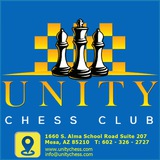The black pieces are totally lacking mobility, whilst White’s cooperate excellently and control all the key squares.
Unity Chess Club
Lev Polugaevsky 2600 Tigran Petrosian 2605 Kislovodsk 1982 White to move
In such a structure, the black Be7 would be better on g7. In that case, his king would feel safer, and the breaks e4-e5 and f4-f5 would not be so terrible. White’s pieces are all pointing at the kingside and on the long diagonal, and the Bb2 has no opponent. Whilst Black has no time to organise himself properly, White attacks.
19...Nh5 20.Ne4 Bxe4 21.Bxe4 dxe5 22.fxe5 leads to a large advantage for White – White can cripple the knight on g7 with g2-g4!.
White uses the same idea as in the game after the preliminary exchange 19...dxe5 20.fxe5 Nd7 21.Be4!. After the exchange of bishops, the white knight breaks into the black position with great effect, whilst after 21...Bc8, White carries out a nice attack: 22.Nd5! exd5 23.Bxd5 Bf6 24.e6! fxe6 25.Bxe6+ Kg7 26.Rxd7+!, mating.
White uses the same idea as in the game after the preliminary exchange 19...dxe5 20.fxe5 Nd7 21.Be4!. After the exchange of bishops, the white knight breaks into the black position with great effect, whilst after 21...Bc8, White carries out a nice attack: 22.Nd5! exd5 23.Bxd5 Bf6 24.e6! fxe6 25.Bxe6+ Kg7 26.Rxd7+!, mating.
By neutralising the enemy light-squared bishop, White ensures his pieces greater room for manoeuvre.
Otherwise, the white knight comes to e4, but now White exploits the greater weakening of the black kingside:
